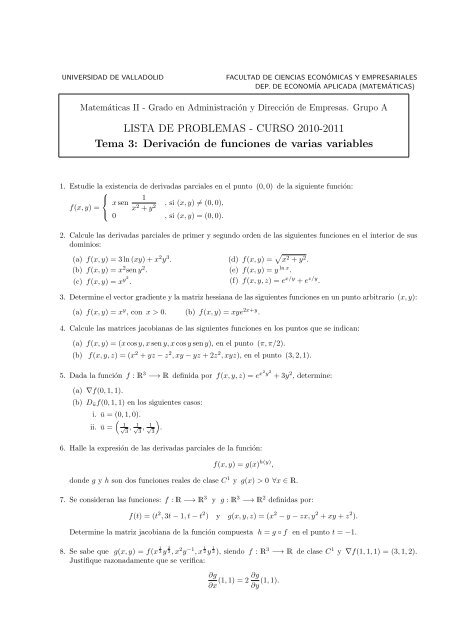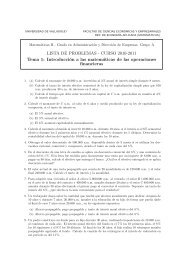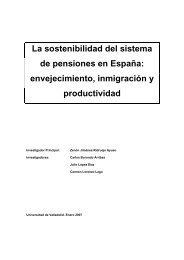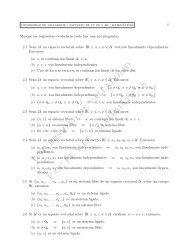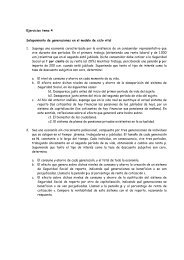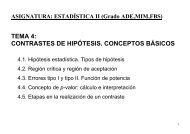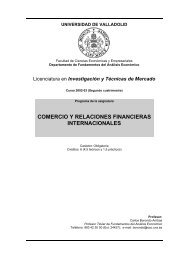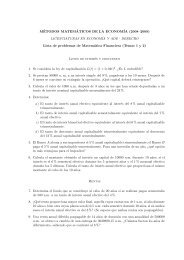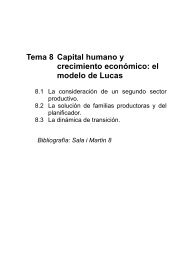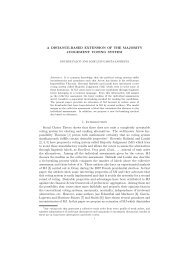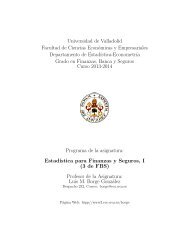LISTA DE PROBLEMAS - Universidad de Valladolid
LISTA DE PROBLEMAS - Universidad de Valladolid
LISTA DE PROBLEMAS - Universidad de Valladolid
You also want an ePaper? Increase the reach of your titles
YUMPU automatically turns print PDFs into web optimized ePapers that Google loves.
UNIVERSIDAD <strong>DE</strong> VALLADOLIDFACULTAD <strong>DE</strong> CIENCIAS ECONÓMICAS Y EMPRESARIALES<strong>DE</strong>P. <strong>DE</strong> ECONOMÍA APLICADA (MATEMÁTICAS)Matemáticas II - Grado en Administración y Dirección <strong>de</strong> Empresas. Grupo A<strong>LISTA</strong> <strong>DE</strong> <strong>PROBLEMAS</strong> - CURSO 2010-2011Tema 3: Derivación <strong>de</strong> funciones <strong>de</strong> varias variables1. Estudie la existencia <strong>de</strong> <strong>de</strong>rivadas parciales en el punto (0, 0) <strong>de</strong> la siguiente función:⎧⎨ 1x senf(x, y) = x⎩2 + y 2 , si (x, y) ≠ (0, 0),0 , si (x, y) = (0, 0).2. Calcule las <strong>de</strong>rivadas parciales <strong>de</strong> primer y segundo or<strong>de</strong>n <strong>de</strong> las siguientes funciones en el interior <strong>de</strong> susdominios:(a) f(x, y) = 3 ln (xy) + x 2 y 3 .(b) f(x, y) = x 2 sen y 2 .(c) f(x, y) = x y2 .(d) f(x, y) = √ x 2 + y 2 .(e) f(x, y) = y ln x .(f) f(x, y, z) = e x/y + e z/y .3. Determine el vector gradiente y la matriz hessiana <strong>de</strong> las siguientes funciones en un punto arbitrario (x, y):(a) f(x, y) = x y , con x > 0. (b) f(x, y) = xye 2x+y .4. Calcule las matrices jacobianas <strong>de</strong> las siguientes funciones en los puntos que se indican:(a) f(x, y) = (x cos y, x sen y, x cos y sen y), en el punto (π, π/2).(b) f(x, y, z) = (x 2 + yz − z 2 , xy − yz + 2z 2 , xyz), en el punto (3, 2, 1).5. Dada la función f : R 3 −→ R <strong>de</strong>finida por f(x, y, z) = e x2 y 2 + 3y 2 , <strong>de</strong>termine:(a) ∇f(0, 1, 1).(b) Dūf(0, 1, 1) en los siguientes casos:i. ū = (0, 1, 0).(ii. ū =1√ 13, √3 1, √3).6. Halle la expresión <strong>de</strong> las <strong>de</strong>rivadas parciales <strong>de</strong> la función:f(x, y) = g(x) h(y) ,don<strong>de</strong> g y h son dos funciones reales <strong>de</strong> clase C 1 y g(x) > 0 ∀x ∈ R.7. Se consi<strong>de</strong>ran las funciones: f : R −→ R 3 y g : R 3 −→ R 2 <strong>de</strong>finidas por:f(t) = (t 2 , 3t − 1, t − t 2 ) y g(x, y, z) = (x 2 − y − zx, y 2 + xy + z 2 ).Determine la matriz jacobiana <strong>de</strong> la función compuesta h = g ◦ f en el punto t = −1.8. Se sabe que g(x, y) = f(x 1 3 y 2 3 , x 2 y −1 , x 1 2 y 1 2 ), siendo f : R 3 −→ R <strong>de</strong> clase C 1 y ∇f(1, 1, 1) = (3, 1, 2).Justifique razonadamente que se verifica:∂g ∂g(1, 1) = 2 (1, 1).∂x ∂y
9. Sea f una función real <strong>de</strong> clase C 1 y F la función <strong>de</strong>finida por:( 1F (x, y) = fy x)− 1 para x ≠ 0, y ≠ 0.2 ∂F (x, y) 2 ∂F (x, y)Compruebe que se verifica x + y = 0 para cualesquiera x ≠ 0, y ≠ 0.∂x∂y10. Una empresa produce un bien w a partir <strong>de</strong> tres factores x, y, z en un proceso <strong>de</strong> dos fases. En laprimera se fabrican dos componentes u, v según la función <strong>de</strong> producción:( √x2)(u, v) = f(x, y, z) = yz , 1 + ln y2.zEn la segunda fase se fabrica el bien w a partir <strong>de</strong> las componentes u, v <strong>de</strong> acuerdo con la funciónw = q(u, v) = ln(uv). Calcule la productividad marginal <strong>de</strong>l factor y en la producción final, suponiendoque los factores iniciales <strong>de</strong> producción son (x, y, z) = (1, 1, 1).11. Calcule las <strong>de</strong>rivadas parciales <strong>de</strong> primer y segundo or<strong>de</strong>n <strong>de</strong> las siguientes funciones en el interior <strong>de</strong> susdominios:(a) f(x, y) = x 3 + x 2 y 3 − 2y 2 .(f) f(x, y) = senx cos y.(b) f(x, y) = sen x1+y .(g) f(x, y, z) = a 1/xyz , a > 0.(c) f(x, y) = xe 3y .(d) f(x, y) = ln(x + √ (h) f(x, y, z) = xy 2 z 3 + 3yz.x 2 + y 2 ).(i) f(x, y, z) = ln(x + 2y + 3z).(e) f(x, y) = x − yx + y .12. Determine el vector gradiente y la matriz hessiana <strong>de</strong> f(x, y) = ln 1que x + y > 0.x+yen un punto arbitrario (x, y) tal13. Calcule las matrices jacobianas <strong>de</strong> las siguientes funciones en los puntos que se indican:√(a) f(x, y) = xy + x , si x > 0, y > 0, en el punto (1, 1).y(b)f(x, y) = y lnx 3 yx 2 , si x > 0, y > 0, en el punto (1, 1).+ y2 14. De una función f : R 2 −→ R <strong>de</strong> clase C 1 se conoce:⎧⎨Calcule ∇f(0, 0).⎩D ( √ 22 , √ ) 2 f(0, 0) = 1,2) f(0, 0) = −1.D ( √ 22 ,− √ 2215. Sea ϕ una función real <strong>de</strong> clase C 1 . Demuestre que si z = ϕ(x 2 +y 2 ) , se verifica y∂z(x, y)x16. Sean f tal que f(0) = f ′ (0) = 1 y g : R 3 −→ R funciones <strong>de</strong> clase C 1 . Se consi<strong>de</strong>ra la función(a) Demuestre que ∂F ∂F(0, 1) = (0, 1).∂x ∂yF (x, y) = g(f(x) + y, f(xy) − x, y + sen (xy)).(b) Compruebe que D¯v F (0, 1) = 0 para ¯v = ( √ 2/2, − √ 2/2).= x∂z(x, y).y2


